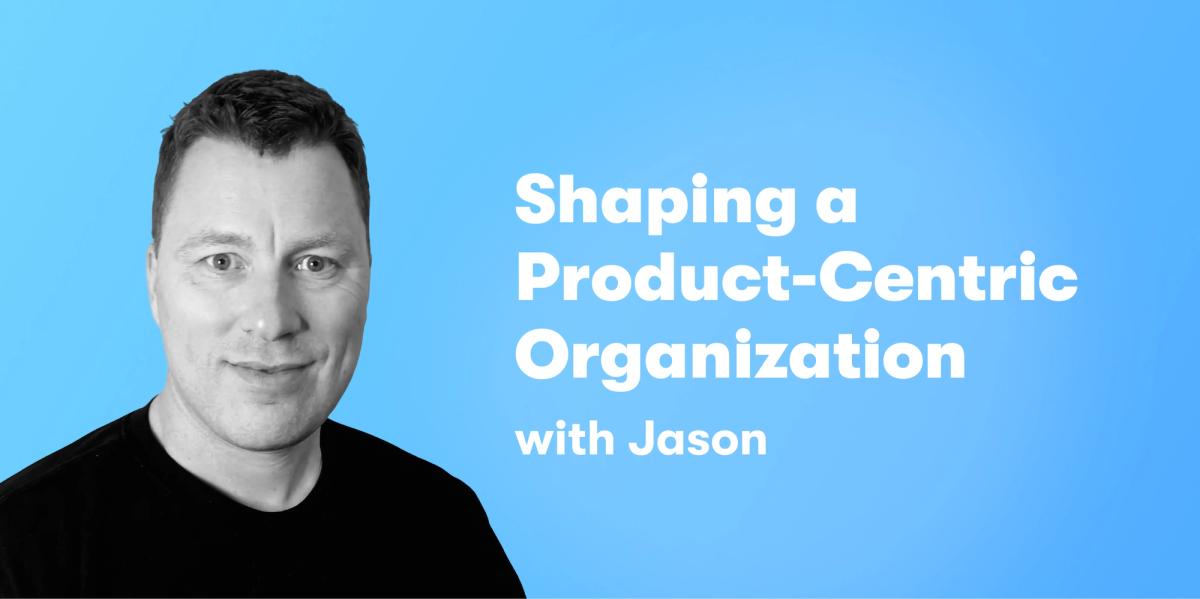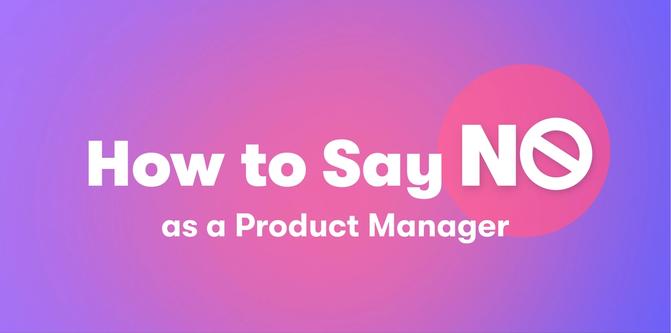Shaping a Product-Centric Organization with Jason Knight

Hey Jason, could you share your background with us and what led you to become a B2B product management consultant?
Well, like all the best product managers, I happened upon product management by mistake. I spent many years working as a developer for a large multinational market research firm, which wasn’t a product company at all. But, as time progressed, and the internet became ubiquitous, we started building more standardized offerings that we could sell again and again. Products!
But, we didn’t really call them that then, and we weren’t in the slightest bit agile (I even got put forward for a PRINCE2 certification once - I demurred). As I moved into tech leadership, and into roles with more global responsibility, I naturally started gravitating towards not just the development but the strategic context behind it, and the why behind the ask, and morphed into a product manager by default. I moved into startups relatively late in my career, having started boning up on all the latest thinking and realizing that there might be better places to try this stuff than in a corporate.
I moved through a handful of startups, leading product teams in a variety of situations, but also really threw myself into the product community through my social media, events and ultimately, a podcast and associated activities. I started talking to so many wonderful product people and getting so many sources of insight that, when I quit my last job with sufficient runway to take a breath, I decided I wanted to go out and help lots of companies and teams, not just one at a time. The rest is… well, not history, as it’s still happening right now. It’s a hell of a ride - every day is exciting and different, but consulting is not without its stresses and strains!
Do you have any experience in transitioning an organization to become more product-centric? What were the key challenges you faced, and how did you overcome them?
Yes, in fact, I would say this is the sweet spot for me at the moment. I’ve worked at various organizations that were undergoing a transition one way or another; either from services-led to product-led, or trying to regroup around a new product or market. You walk into situations that are entirely unlike most books (although there are some great ones out there that try to get into it).
The interesting thing is that, of all the challenges I’ve either personally encountered, or heard second-hand through my coaching and mentoring efforts, there are so many common challenges across industries. Now, this could be because I attract a certain type of client, but I don’t think it’s just that. I do a lot of fireside chats (free Q&As with product teams) and they’re all asking the same questions too!
The problems are almost always around a lack of product mindset (not being sensitive to the needs of entire markets, focusing on quick wins rather than repeatable, scalable success, and treating everything as a project to be executed). This sounds like a cliche or a criticism but, actually, in many cases, there’s no reason for people to have a product mindset. If a leadership team hasn’t worked in strong product organizations before and has done everything they can, by hook or by crook, to help their company survive then they’re going to have made some suboptimal decisions along the way. The sweet spot for me is when I can get into a company after it’s got past the initial idea stage, but before these dysfunctions are almost irreversibly bedded in.
In your opinion, what are the essential steps product managers can take to align their teams and stakeholders around a shared product vision?
Well, first of all, product managers need to take more responsibility to have an actual vision in place, alongside a strategy to achieve it. Now, in many companies, this is easier said than done, either because the leadership team is still driving everything, or the aforementioned project mindset means people get distracted easily. It can feel difficult, or pointless, pulling a vision together if you don’t have any confidence that you’re going to get to move towards it.
But, again, I think it’s important for product managers to do the work anyway. You’re never going to escape a feature factory mindset if you just accept it. You need to do the work. This involves crafting that vision and strategy, doing your utmost to defend it (whilst being sensitive to business realities that might - hopefully temporarily - derail it) and ensuring that you evangelize and publicize this all the time. All the time! Don’t stop… People have short attention spans or they miss meetings or they mishear something. Be super, super-clear with your language and try lots of different ways to get the message across (visual, diagrams, audio, text, documents!) You need to hit all of people’s nerve endings to have a chance of making it stick.
How can product managers effectively communicate the importance of a product-centric approach to senior executives and leaders who may have different priorities?
By collecting their favorite Medium influencer articles about product management, printing them out and asking the CEO to read them.
Just kidding! This is one of the hardest challenges in many companies. Not because the leadership team is thick, or because they don’t want to change, but because many of the things we try to say to them might as well be in Klingon. Product managers live in intense ambiguity and often find solace in books and articles and broetry, but most of this doesn’t survive contact with the real world.
The most important thing I’ve learned is that, when you start to sound like you’re proselytizing, you’ve already lost the debate. One thing I constantly recommend PMs to do is to translate all of the things they care about (discovery, data, users, outcomes) into things that non-product people care about (money, risk, excitement). It doesn’t mean we need to abandon our principles, just find better ways to describe them.
What strategies have you found successful in breaking down silos and fostering collaboration among different departments and teams to support a product-centric culture?
For me, one of the most important things is for product managers to understand their colleagues. As product managers, we spend quite a lot of time moaning about how much user research we don’t get to do, and how we want to deeply empathise with them. But, we often fail to turn that lens on our colleagues and stakeholders, and we should try harder there. It’s really easy to commit Fundamental Attribution Error and just assume that all your colleagues are dumb because they don’t get it. But, guess what? You don’t get them either! Let’s find out what their goals and motivations are. Let’s work out what they’re being measured against. Maybe it’s different from what you’re being measured against! That’s a problem to solve with leadership, but you can’t solve it until you’ve identified it.
Other than that, I’m a strong believer in getting people involved and constantly communicating with them. Remember, not everyone is going to immediately “get it”. That’s OK! You probably couldn’t do their job either. But, if we find common ground with people and get them to agree that such-and-such is a problem (even if they don’t naturally agree with your solution) then you can make them partners in solving it rather than just foisting a solution on them.
How can product managers involve stakeholders from various departments, such as marketing, engineering, and design, early in the product development process to ensure alignment and collaboration?
Well, here is where we get into Goldilocksing. We don’t want to have everyone in every meeting; that’s massively inefficient and most people aren’t needed all the time. But, on the other hand, how do they know which meetings to go to?
I actually quite like using shared documentation to help solve this. Not massive PRDs that no one ever reads, but short, sharp, punchy documentation with clear signposting that shows what is being done, why and how. I also love getting this stuff up early, rather than trying to craft a perfect little flower. Get your documents up and shared early! I love the “request for comments” model where anyone can add a comment to anything. You don’t have to act on all the comments (it’s still the product manager’s job to apply critical thinking), but at least people have had a chance to give feedback. I also recommend regular (say, monthly) catch-ups with all of the main functions just to have a bi-directional update on any general topics.
What role does data play in driving a product-centric organization? How can product managers leverage data effectively to make informed decisions and shape the product vision?
To leverage data effectively, you have to have the data. Luckily, these days, there are lots and lots of different tools that you can integrate with your solution to get almost limitless data on what people are doing in your apps. I’m a big fan of the product analytics platforms (although I sometimes get in trouble at conference expos when I tell analytics vendors that all their platforms do the same job!) and also session recorders that allow playback of user sessions (with sensitive data excluded) to enable you to zoom in on individual behaviors as well as get the macro view. I think it’s essential to get at least some level of basic analytics into any platform, and I’d never build my own.
What role does it play? It’s incredibly important to have visibility on your product usage. How can you know what people are doing if you don’t measure it? You can make great decisions on prioritization if you have all the facts. But, these can only tell you what happened, not why, so it has to be married with good user research. And, it’s also important to realize that sometimes there’s a healthy dose of gut feeling that might inform your actions. This might sound counterintuitive, and no one wants to make a $150M decision based on gut, but if you make appropriately-sized bets then it’s a valid way to get real data on whether that worked or not.
How do you approach balancing short-term business needs with long-term product strategy? What advice would you give to product managers who struggle with the tension between immediate financial goals and product innovation?
It’s really hard! You’re going to get intense pressure from various senior stakeholders, and many product managers will fold under this pressure. I’ve folded under this pressure before. Now, in some cases, that might have been the right move. The thing that we need to do in situations like this is not just fold by default, but do some good product management around the ask.
We may end up building the new thing because Big Customer X said they won’t sign the deal without it, but does it pass the sniff test? Is it something that we would legitimately like to build, but just not yet? Can we go and speak to a handful of other customers to find out whether it’s something they would find useful too? Can we make sure that we don’t build ourselves down a dead-end just for one customer? And, in all cases, how can we build the smallest possible thing to solve this need?
I recently posted about how ad hoc requests are only a problem if the rate of requests exceeds how fast you can answer them. This either means you need to speed your development up, or you need to slow down the rate of requests (or, ideally, both). A great way to speed up your development is to work on really small stuff.
What are some effective strategies for gathering customer insights and feedback to inform the product vision and ensure that the organization remains customer-centric?
Well, I’m a product guy, so I’m going to say that product discovery is crucial, and this should be led by the product team. But, there are so many other people talking to customers all the time, and we can’t ignore these people. Now, it’s fair to say that not all of these conversations will be asking the questions we would ask, but they’re still asking questions. It’s important to take this feedback, apply the relevant weight to it, look for signals and handle it appropriately. Maybe it’ll give you some ideas for further investigations. Maybe it’ll give you additional insight into something you were already investigating. Remember, you can prime Sales and CS teams to ask some of these questions with prospects or customers. You absolutely need to work with these people, and not try to go around them. We all need to realize we’re in this together.
What are some common roadblocks or resistance product managers might encounter when trying to shift the organization towards a product-centric mindset, and how can they navigate those challenges?
If companies have project mindsets, are seeing everything deal by deal, or are used to bending over backwards for massive customers, it can be incredibly difficult to get away from the attitude that the customer is always right. Now, the customer is generally right about their own problems within their own context, but most customers don’t care whether what we do suits anyone else. They just have their own problems to solve. And, to be honest, I get it. That’s what I want when I send a support request to a company too. But, there are problems and there are problems. I’ve seen companies try to get literally every single incoming request estimated and scheduled, alongside all of the strategic work that’s really needed to move the company forward. It’s never going to happen, and you burn cycle after cycle re-triaging issues and responding to complaints that it’s not done yet. But, on the other hand, no one’s used to saying no. Sometimes it’s important to hold the line, but product managers also need to be able to apply critical thinking to when they might bend. No one wins a competition for being the purest product manager. We have to do the best for our businesses as well as our users.
How important is executive support in fostering a product-centric culture, and how can product managers gain and maintain that support?
Executive support is critical. It’s all very well trying to solve this from the bottom up (and people have a lot more power to try things there than they think), but if every single pressure point becomes an escalation then it’s incredibly hard to make progress.
But, let’s think about what the executives of a company want. They want the company to be successful! They want the company to scale! They want the benefits of repeatable, scalable revenue and it’s our job to show them how our approaches are going to get them there. It’s hard to argue with salespeople trying to make their numbers, but what have we done to help them make their numbers? Are we really working on the most important stuff? Have we actually fleshed out why our strategy is going to work, and the opportunity cost of jumping after any old random initiative? Some people seem surprisingly immune to evidence, but we can’t blame them if we don’t provide the evidence in the first place. Let’s all make sure we give our leadership teams the best story we can, rather than getting dragged into ideological battles, and we can all win together.
Lastly, what are you up to these days and where can people find you?
I’m doing a few things. I’ve still got the podcast, One Knight in Product, which has been going for around about 3 years now. It’s an incredible way for me to learn, and hopefully help others, whilst also getting to speak to people that, frankly, I have no right to speak to! I also write an accompanying newsletter with semi-regular thoughts about the crazy world of product management. People can hire me as an advisor, coach or interim product leader at One Knight Consulting, or if they want a free mentor they can head over to my startup, My Mentor Path. I also love connecting with people on Twitter, Threads or LinkedIn. I love to chat!






